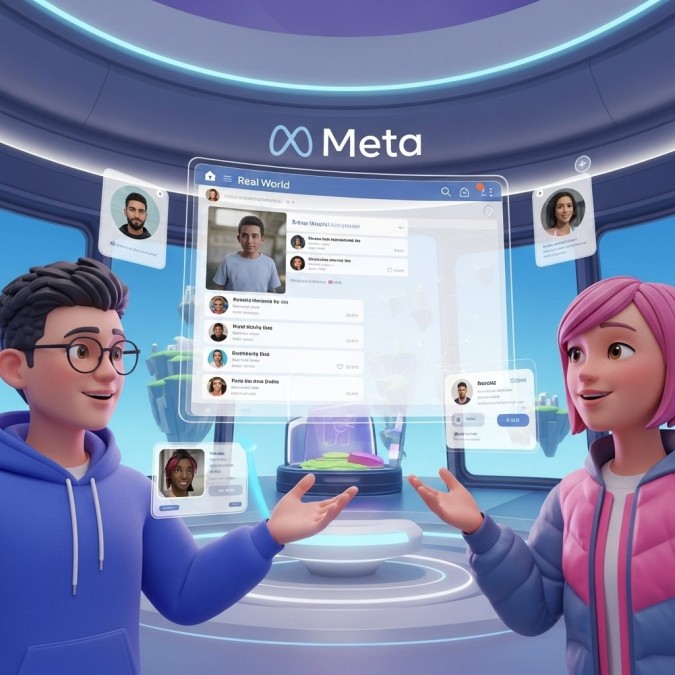🧠 Meta’s Horizon Worlds: Social Media in VR?
Exploring the Future of Connection, Creation, and Commerce in Virtual Reality
Section 1: The Birth of Horizon Worlds — Meta’s Vision for a Social VR Ecosystem
When Meta (formerly Facebook) announced its pivot toward the “metaverse,” many dismissed it as a buzzword-heavy rebranding exercise. But Horizon Worlds, Meta’s flagship social VR platform, is more than a marketing stunt—it’s a bold attempt to redefine how we socialize, create, and interact online.
🧭 What Is Horizon Worlds?
Horizon Worlds is a free-to-access virtual reality platform built for the Meta Quest headset ecosystem. It allows users to:
- Create immersive 3D environments (“worlds”)
- Interact with others via avatars
- Host events, games, and collaborative experiences
- Monetize creations through in-world purchases
Think of it as a blend of Roblox, VRChat, and Facebook Groups—except fully immersive and spatial. Users don’t scroll through feeds; they walk through them. They don’t comment on posts; they talk to avatars in real time.
🧱 The Building Blocks of Social VR
At its core, Horizon Worlds is a sandbox. Creators can use Meta’s built-in tools to design environments, script interactions, and publish experiences. These worlds can be public or private, gamified or educational, social or commercial.
Meta has invested heavily in making these tools accessible. The Horizon Worlds desktop editor now supports AI-generated assets, meaning creators can describe what they want—“a neon-lit cyberpunk alley with interactive vending machines”—and the system will generate it.
This democratization of content creation is key. Just as Instagram turned everyone into a photographer, Horizon Worlds aims to turn everyone into a VR world builder.
📈 Growth, Struggles, and Strategic Shifts
Despite Meta’s deep pockets and aggressive marketing, Horizon Worlds struggled to gain traction in its early years. Engagement was low, retention was poor, and many worlds felt empty or underdeveloped.
To address this, Meta made several strategic moves:
- Opened Horizon Worlds to non-VR devices (phones, desktops)
- Introduced a $50M Creator Fund to incentivize high-quality content
- Added gamification features like Avatar Quests and XP systems
- Integrated AI-powered NPCs for dynamic, unscripted interactions
These changes have started to pay off. Horizon Worlds now boasts a growing user base, with creators earning bonuses based on retention, time spent, and in-world purchases.
Section 2: Social Media Reimagined — How Horizon Worlds Changes the Game
Meta’s ambition isn’t just to build a VR playground—it’s to redefine social media itself. Horizon Worlds represents a shift from 2D feeds to 3D presence, from passive scrolling to active participation.
🧍♂️ Avatars as Identity
In Horizon Worlds, your avatar is your profile. You can customize its appearance, voice, and even behavior. Meta has introduced avatar achievements, quests, and social badges that reflect your activity across VR experiences.
This gamification of identity is powerful. It encourages exploration, competition, and collaboration. It also opens the door to new forms of self-expression—especially for younger users who grew up in Minecraft, Fortnite, and Roblox.
🗣️ Real-Time Interaction vs. Asynchronous Posting
Traditional social media is asynchronous. You post a photo, someone likes it hours later. Horizon Worlds flips this. You enter a space, and you’re immediately interacting with others—talking, playing, building.
This real-time engagement fosters deeper connections. It’s more akin to hanging out in a café than browsing a feed. For brands, educators, and influencers, this means higher-quality interactions and more memorable experiences.
🧠 AI-Powered NPCs and Smart Worlds
One of Horizon Worlds’ most exciting innovations is the introduction of AI-powered NPCs (non-player characters). These aren’t just scripted bots—they’re dynamic, conversational agents powered by Meta’s Llama language model.
Creators can define NPCs with:
- Names and backstories
- Personality traits and dialogue styles
- Triggered actions and quests
These NPCs can guide users, offer lore, sell virtual goods, or even react emotionally to player choices. It’s a leap forward in immersive storytelling and social simulation.
🛍️ Commerce and Monetization
Meta has also introduced monetization tools:
- In-world purchases (skins, items, access)
- Creator bonuses tied to engagement
- Subscription models for premium worlds
This turns Horizon Worlds into a viable platform for entrepreneurs. Imagine a Thai-English bilingual educator creating a virtual classroom, charging access fees, and selling branded learning materials—all inside VR.
Section 3: Challenges, Opportunities, and the Road Ahead
While Horizon Worlds is promising, it’s not without challenges. From technical limitations to cultural adoption, the road to mainstream social VR is complex.
⚠️ Technical and UX Barriers
VR still has friction:
- Headsets are expensive and bulky
- Motion sickness affects some users
- Battery life and resolution are limiting factors
Meta has tried to address this by opening Horizon Worlds to non-VR devices, but the experience is less immersive. Balancing VR-native features with cross-platform accessibility remains a challenge.
🧩 Content Quality and Moderation
Social VR platforms face unique moderation challenges. In Horizon Worlds, users can build anything—meaning moderation must be proactive, not reactive.
Meta has implemented safety tools, reporting systems, and AI-based content filters. But as the platform grows, maintaining a healthy ecosystem will require constant vigilance.
🌍 Cultural and Behavioral Shifts
Social VR demands a new kind of digital literacy. Users must learn to navigate spatial environments, manage avatar interactions, and understand virtual etiquette.
For older users or those unfamiliar with gaming, this can be intimidating. Meta must invest in onboarding, tutorials, and community-building to ease this transition.
🔮 The Future of Horizon Worlds
Despite these hurdles, Horizon Worlds is evolving rapidly. Upcoming features include:
- AI-generated environments via voice prompts
- AR glasses integration for mixed-reality experiences
- Expanded creator tools for desktop and mobile
- Deeper integration with Instagram, WhatsApp, and Messenger
Meta’s long-term vision is clear: a unified ecosystem where users move seamlessly between VR, AR, and traditional apps—connected by avatars, AI, and immersive content.
If successful, Horizon Worlds could become the next-generation social media platform—one where presence replaces posting, and creation replaces consumption.
📝 Final Thoughts
Meta’s Horizon Worlds is more than a VR experiment—it’s a reimagining of how we connect, create, and communicate online. By blending immersive environments, real-time interaction, and AI-driven content, it offers a glimpse into the future of social media.
For creators, educators, and entrepreneurs, Horizon Worlds presents a new frontier. It’s a place to build branded experiences, host virtual events, and engage audiences in ways that 2D platforms simply can’t match.
But success will depend on execution. Meta must balance innovation with accessibility, creativity with safety, and ambition with empathy. If it can do that, Horizon Worlds may not just be the future of VR—it may be the future of social media itself.



